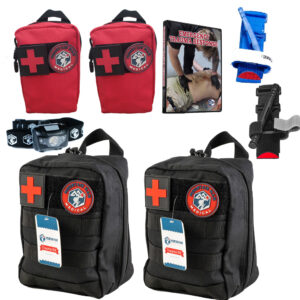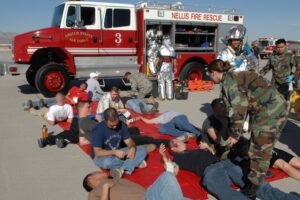AB2260: California’s Mandate for Trauma Kits in Organizations

Acknowledging the unpredictable nature of emergencies and the potential for life-threatening situations, California has taken a significant step towards enhancing preparedness. Assembly Bill 2260 (AB2260) stands as a landmark legislation that mandates organizations to maintain trauma kits, thereby ensuring a safer environment for both employees and the general public.
Why Was AB 2260 Put into Law?
It was introduced in response to the increasing frequency of emergencies, ranging from natural disasters to man-made incidents, such as shootings and accidents. The legislation recognizes that quick and effective response during the critical minutes following an incident can significantly improve outcomes. Trauma kits, equipped with essential medical supplies, play a crucial role in providing immediate first aid and stabilizing victims until professional medical assistance arrives.
The rationale behind the law is understanding that organizations, whether public or private, are integral parts of the community and bear a responsibility to contribute to public safety. By mandating the presence of trauma kits, the legislation aims to empower organizations to be proactive in their approach to emergency preparedness.
AB 2260 was authored by Assemblymember Freddie Rodriguez (D – Pomona), who had this to say:
“As Chair of the Emergency Management Committee and a career Emergency Medical Technician (EMT) for over 35 years, I am committed to ensuring all Californians are prepared for every type of disaster, including mass casualty events and sudden bleeding. Having trauma kits available for bystanders to serve as immediate responders during a mass bleeding incident will increase a victim’s chance of survival, ultimately saving lives.” asmdc.org

AB2260 outlines specific requirements for organizations regarding the establishment and maintenance of trauma kits.
AB2260 Requirements:
- Minimum Standards for Trauma Kits: The legislation establishes minimum standards for the contents of trauma kits, ensuring that they contain essential supplies such as bandages, tourniquets, gauze, and other items necessary for immediate first aid which are available on the MountainManMedical.com store.
- One tourniquet endorsed by the Committee on Tactical Combat Casualty Care.
- One bleeding control bandage.
- One pair of nonlatex protective gloves and a marker.
- One pair of scissors.
- Instructional documents developed by the Stop the Bleed national awareness campaign of the United States Department of Homeland Security or the American College of Surgeons Committee on Trauma, the American Red Cross, the Committee for Tactical Emergency Casualty Care, or any other partner of the United States Department of Defense.
- Depending on your facility/institution/building, the requirements for emergency response trauma safety may demand additional components in your trauma kits. You must contact the medical director of your local emergency medical service agency for approval of any additional medical materials that you find may be useful to the civilians in your business to adequately treat a traumatic injury. NV5.com

- Training Requirements: AB2260 emphasizes the importance of training designated personnel within organizations to use the trauma kits effectively. This includes basic first aid and life-saving techniques, ensuring that individuals are prepared to respond confidently in emergency situations. Mountain Man Medical offers our own Online class that is completely free and will teach you how to use all the items in your new trauma kits.
- Accessibility and Visibility: The law mandates that trauma kits must be easily accessible and prominently displayed within the organization. If AED (automated external defibrillator) is on location as well, they should be stored next to each other. This ensures that in times of crisis, individuals can quickly locate and utilize the necessary supplies.
- Regular Inspections and Maintenance: Organizations are required to conduct regular inspections of trauma kits to ensure that contents are up-to-date and in good condition. Each kit is required to be inventoried at least every 3 years and expired items are to be replaced. This proactive measure ensures the reliability of the kits when they are needed most.

What Building are Required to Have Trauma Kits?
The occupancy amount reflects regulations and standards of fire safety and hazards that may be involved relative to the building. The bill indicates that 6 trauma kits apply to the following occupancy amounts based on the following building descriptions:
- Group A: Assembly buildings with an occupancy of greater than 300.
- Group B: Business buildings with an occupancy of 200 or more.
- Group E: Educational buildings with an occupancy of 200 or more.
- Group F: Factory buildings with an occupancy of 200 or more.
- Group I: Institutional buildings with an occupancy of 200 or more.
- Group M: Mercantile buildings with an occupancy of 200 or more.
- Group R: Residential buildings with an occupancy of 200 or more, excluding single-family and multifamily dwelling units. NV5.com

Benefits of AB2260 to the Community:
- Improved Emergency Response: The presence of trauma kits ensures that immediate first aid can be administered in the crucial moments following an incident. This can significantly improve the chances of survival and reduce the severity of injuries before professional medical help arrives.
- Enhanced Workplace Safety: For businesses and institutions, the mandate promotes a safer work environment. Employees feel more secure knowing that their workplace is equipped to handle emergencies, instilling a sense of well-being and confidence.
- Community Resilience: By extending the mandate to various organizations, including schools, shopping centers, and public facilities, the law contributes to community-wide resilience. In times of crisis, these locations become hubs for support and assistance, reinforcing the community's ability to recover and rebuild.
- Cost-Efficient Preparedness: While some organizations may initially view the implementation of trauma kits as an added cost, the long-term benefits outweigh the expenses. Quick and effective first aid can prevent more severe injuries, potentially reducing the overall cost of medical treatment and rehabilitation.
- Public Awareness and Education: The law also serves to increase public awareness and education on emergency preparedness. As organizations implement the legislation, they naturally engage employees and the community in discussions about safety protocols, further fostering a culture of preparedness.
Doc’s Wrap Up
AB2260 represents a significant step forward in promoting safety and preparedness in organizations across the state of California. By mandating the presence of trauma kits and establishing clear guidelines for their use, the legislation improves the overall resilience of communities. As organizations embrace their role in contributing to public safety, the positive impact of AB2260 is poised to extend beyond the workplace, creating a safer and more prepared California for everyone.
